Address any questions or comments regarding this newsletter to the individual authors listed after each article or to its editors, Nathan Johanning, 618-939-3434, njohann@illinois.edu or Bronwyn Aly 618-695-6060, baly@illinois.edu. The Illinois Fruit and Vegetable News is available on the web at: http://ipm.illinois.edu/ifvn/. To receive or be removed from email notification of new postings of this newsletter, contact Nathan Johanning or Bronwyn Aly at the phone numbers or email addresses above.
In This Issue:
Upcoming Programs ((listings for beginning and established growers))
News & Announcements ((Condolences, Summer Horticulture Field Day Held at Tanner’s Orchard))
Regional Reports ((St. Louis Metro East, southern Illinois, Dixon Springs (including information on White mold and Gray mold in High Tunnel Tomatoes)))
Fruit and Vegetable Pest Management ((Modified Growing Degree Days from Jan 1 through June 17, Farm inventory survey and farm inspections for Illinois under the Food Safety Modernization Act Produce Rule))
Upcoming Programs
Check the Illinois SARE calendar for a full list of programs and links for registration.
http://illinoissare.org/ and http://illinoissare.org/calendar.php
Also see the University of Illinois Extension Local Food Systems and Small Farms Team’s website at:
http://web.extension.illinois.edu/smallfarm/ and the calendar of events at http://web.extension.illinois.edu/units/calendar.cfm?UnitID=629.
- 2019 Southern Illinois Summer Twilight Mileur Orchard, Monday, July 8, 2019 at 6 p.m. This orchard operation, established in 1961, has evolved to now grow over 30 varieties of peaches, 9 varieties of apples along with apriums, pluots, and plums. The program will cover production and marketing along with the steps the Mileur’s took to set up their commercial kitchen for making baked goods to sell from their fruit. For more information or to register, please contact Nathan Johanning at njohann@illinois.edu; 618-687-1727 or Bronwyn Aly, baly@illinois.edu; 618-252-8391.
- August 19, 2019 – Jackson County Extension Office to host final Southern Illinois Summer Twilight Meeting
- Master Urban Farmer Training Program (MUFTP) This 11 week program is scheduled on Wednesdays, June 19 - Aug 28, 2019 from 5:30 - 8:30 pm. Training location is Prairie State College Matteson Area Center, 4821 Southwick Drive, Matteson, IL 60443
This program is best suited for:
- Entrepreneurs who want to start an intensive urban produce farm operation.
- Community leaders in underserved/food insecure communities who want to develop their food production skill set to increase food security and establish a community food system project in their neighborhood.
- Master Gardeners and Naturalists interested in intensifying their food production skill set.
- Educators who want to bring food production knowledge back to their organization.
Interested parties can apply through June 7 at https://go.illinois.edu/MUFTP. For more information contact Sarah Batka at 708-679-6889 or sbatka@illinois.edu.
Summer Horticulture Field Day Held at Tanner’s Orchard
The Illinois State Horticulture Society, Illinois Specialty Growers Association, and University of Illinois Extension joined to hold their annual Summer Horticulture Field Day at Tanner’s Orchard near Speer, IL on Thursday, June 13, 2019. Over 130 people from across the state attended, getting a chance to see the Tanner’s new retail facility, orchard, including high density apple production, and vegetable crops. Here are just a few pictures from the event.
For more information about becoming a member of the Illinois Specialty Growers Association and one of its affiliate organizations like the Illinois State Horticulture Society visit www.specialtygrowers.org

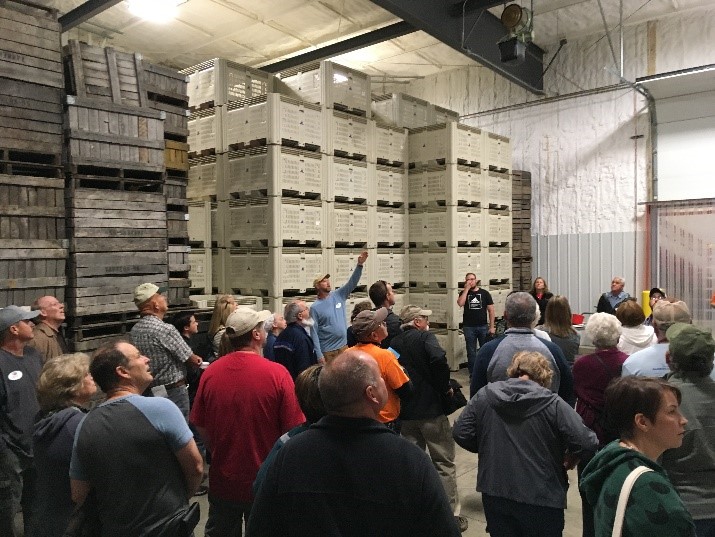
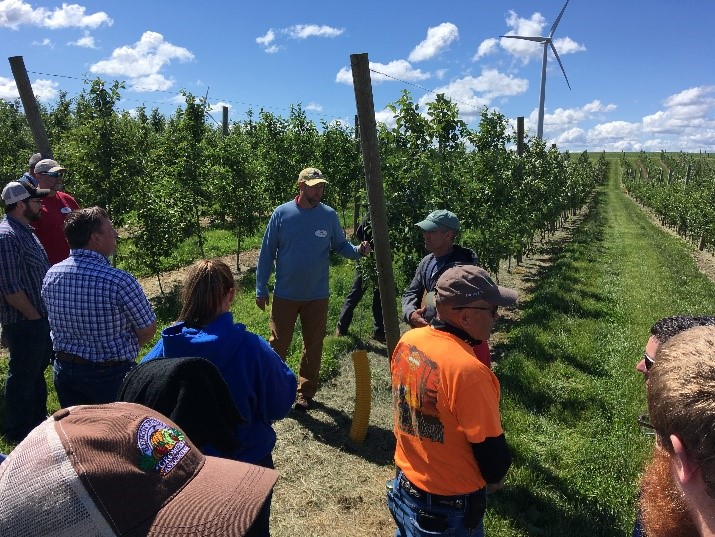

Pictures from the Summer Horticulture Field Day at Tanner’s Orchard in Speer, IL. Photos: N. Johanning
For more information about becoming a member of the Illinois Specialty Growers Association and one of its affiliate organizations like the Illinois State Horticulture Society visit www.specialtygrowers.org
Nathan Johanning (618-939-3434; njohann@illinois.edu)
News & Announcements
Condolences
We extend our sympathy to the Flamm Family of Cobden, IL on the passing of Lenoard “Slim” Flamm on June, 19, 2019. Slim was the 4th generation of the family operating Flamm Orchards. The family will celebrate Slim’s life with a visitation at the Rendleman-Hileman Funeral Home in Cobden, Illinois, on Friday night, June 21, 2019 at 5:00 p.m. to 8:00 p.m. with a brief memorial to be held at 7:30 p.m. during visitation. A funeral mass at St. Joseph’s Catholic Church on Saturday morning June 22, 2019 at 10:00 a.m. will be performed.
For the full obituary and details visit: https://rendlemanhilemanfh.com/?tag=leonard-l-flamm-jr-leonard-l-flamm-jr-obituary-funeralworks-obituary.
Regional Reports
From the St. Louis Metro East… Peach harvest has started in the St Louis Metro East with PF-5, Glenglo and PF-1. Flood waters are coming down around Colhoun County, finally giving some access to growers to market their crop. The Mississippi River side is now open. The Illinois River side along IL-16 is still closed due to flooding and a levy breech, bring it near to 1993 flood stage. The Kampsville Ferry just opened and the Brussel’s Ferry is expected to open next week. Apples are sizing and growers are advised to stay on top of their bitter rot program. Blackberry harvest has started, with Natchez up next. Grapes are at or approaching lag phase, meaning berries have reached at least half of their final size. Most grape growers have applied their last mancozeb spray (66 PHI) and now need to switch to mixtures containing captan instead. Pumpkin planting is in full swing, as well as a number of other succession plantings like sweet corn. Most horseradish harvest is completed and this was a year when planting overlapped harvest.
Elizabeth Wahle (618-344-4230; wahle@illinois.edu)
From southern Illinois... Some of us have finally gotten at least a partial break from the rain in the last few weeks. Over the weekend (6/15-16) some areas had anywhere from 0.5” to 5”+ and everything in between. Here in Murphysboro we had 1.5” and then throughout the week spotty showers have peppered the region. Conditions can go from muddy to dusty within miles. Temperatures have mainly been in the 80s for highs with a fair amount of humidity (especially right after one of those pop-up storms.) There have been some opportunies to get out in the field, but certainly not quite enough to allow time for everyone to catch up on field work.
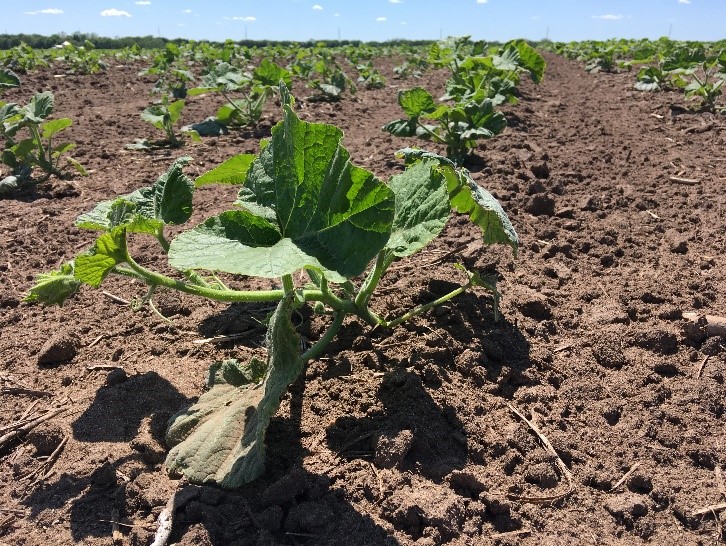
Processing pumpkin field near South Pekin, IL. Photo: N. Johanning
We are into the early peaches like Desiree, early blackberries, and early blueberries like Duke and Earliblue. Blueberries especially seem to be just loaded with fruit. I think the adequate moisture starting late last summer (2018) when flower bud development was occuring for this season was in part the reason. Dry period in the late summer early fall can be hard on blueberries at this critical time to set the next year’s crop. While I have heard of or scouted for spotted winged drosophila (SWD) now would be the time we would be seeing them and certainly I would plan to protect any small fruits from infestations. Here is a good refresher on SWD from IFVN 22:7 with an article on identification and management. We are seeing high tunnel tomatoes fairly readily. Our high tunnel at the office has been yielding some cucumbers and cut flowers with lots of peppers and tomatoes that will be ripening soon.
Pumpkins are going in across the region. I personally have my pumpkin transplants started and hopefully they will get in the ground in the next week to 10 days if the weather cooperates. I had a chance while traveling to visit a commecial processing pumpkin field near South Pekin last week. Plants were just getting ready to fall over and off to a good start.
I enjoyed getting to see many of you at the Summer Hort Field Day at Tanner’s last week!
Nathan Johanning (618-939-3434; njohann@illinois.edu)
From Dixon Springs Ag Center…The morning of the twilight meeting (June 17th) we discovered that we had a couple of disease issues in our in-ground tomato beds. I sent a photo to Dr. Babadoost and he confirmed my suspicion, one of the diseases is white mold or timber rot. For accurate disease diagnosis, the best practice is to send a sample to the University of Illinois Plant Clinic. Because the picture I sent him revealed the very classic tan/light brown, dried and woody looking stem tissue lesion and sclerotia (black fungal bodies) could be easily seen, we felt comfortable with the photo diagnosis. I remember Jeff Kindhart very poetically describing this disease several years back, saying “…when you slice that stem open, if you see rabbit turds, you know you have a problem.”
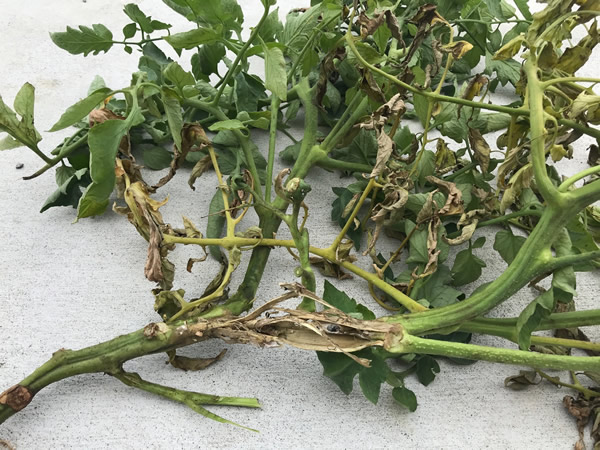
Tomato plant in the DSAC high tunnel with white mold or timber rot. The irregularly shaped black fungal bodies, sclerotia, can be easily seen in the above photo. Photo by B. Aly.
In researching more about this disease, how we may have become infected and what control options would be effective, it appears that this disease is not common in field grown tomatoes but can be very problematic in high tunnel production. Favorable conditions for this disease include high humidity, cool temperatures, and moist conditions. Venting high tunnels in the evening and spacing tomatoes far enough apart to allow for good airflow can help reduce the severity of the disease. The sclerotia survive in the soil from year to year, producing mushrooms and subsequent spores in the spring. Spores can infect flower petals, young succulent tissue, or older senescing tissue and may survive several weeks. In following Dr. Babadoost’s recommendation, we will be removing plants to hopefully reduce the amount of sclerotia that may come in contact with the soil in the raised beds. An article from the Vegetable Crops Hotline, https://vegcropshotline.org/article/white-mold-of-vegetables/, referenced a biological control option we plan to try this fall after all of the plants are removed. There are currently no fungicides that are effective against white mold.
The second disease we discovered was gray mold, another common disease in high tunnels but not usually found in field planted tomatoes. Like white mold, gray mold also likes cooler temperatures and high humidity, so the same cultural practices to reduce white mold severity are also beneficial in the battle against gray mold. Fortunately, unlike white mold, there are several fungicide options available (check in the Midwest Vegetable Production Guide for Commercial Growers 2019 and always read and follow labels carefully) that can be effective in a high tunnel production system to control gray mold.
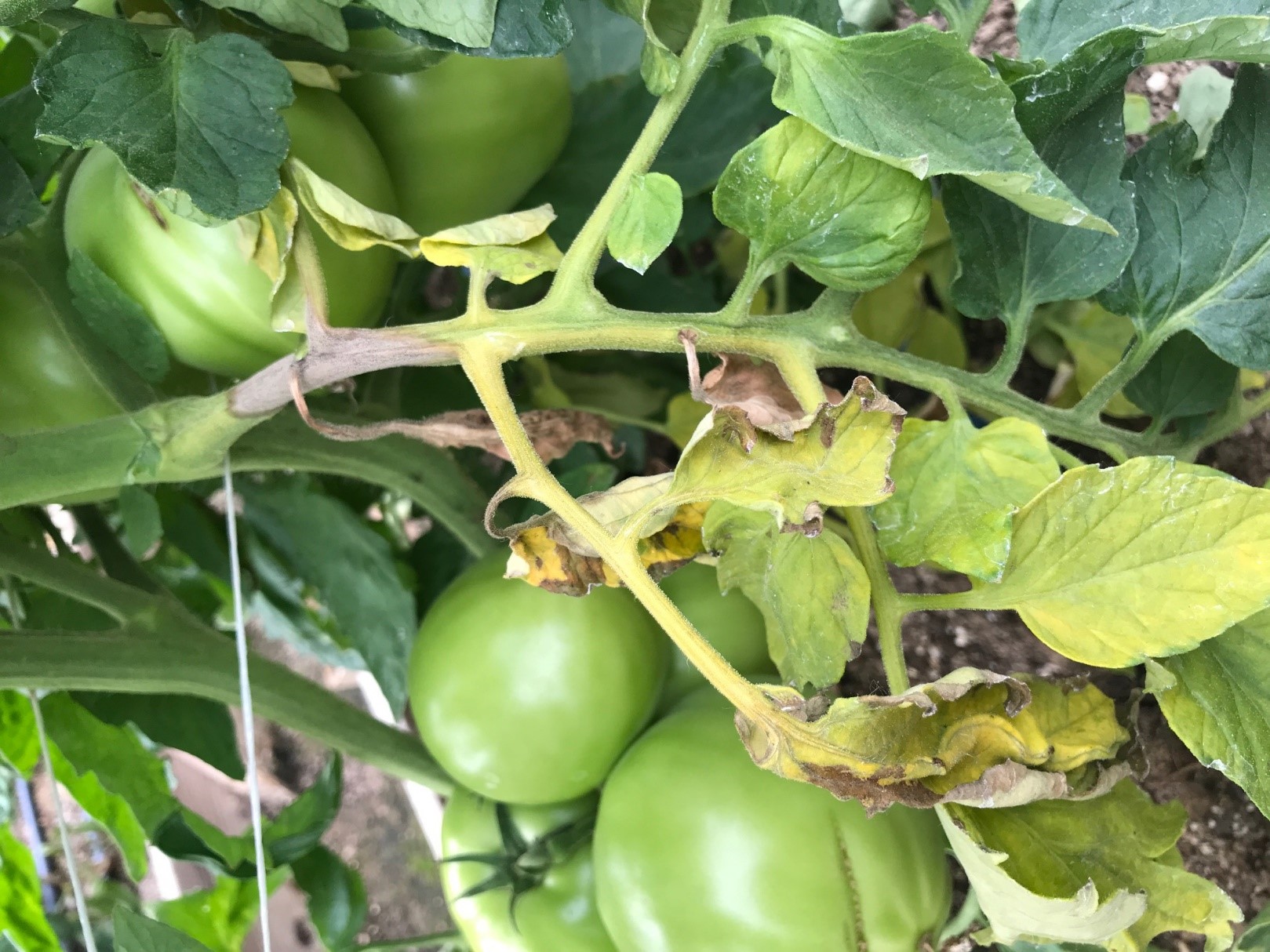
Gray mold on tomato leaf stem from plant in high tunnels at DSAC. Photo by B. Aly.
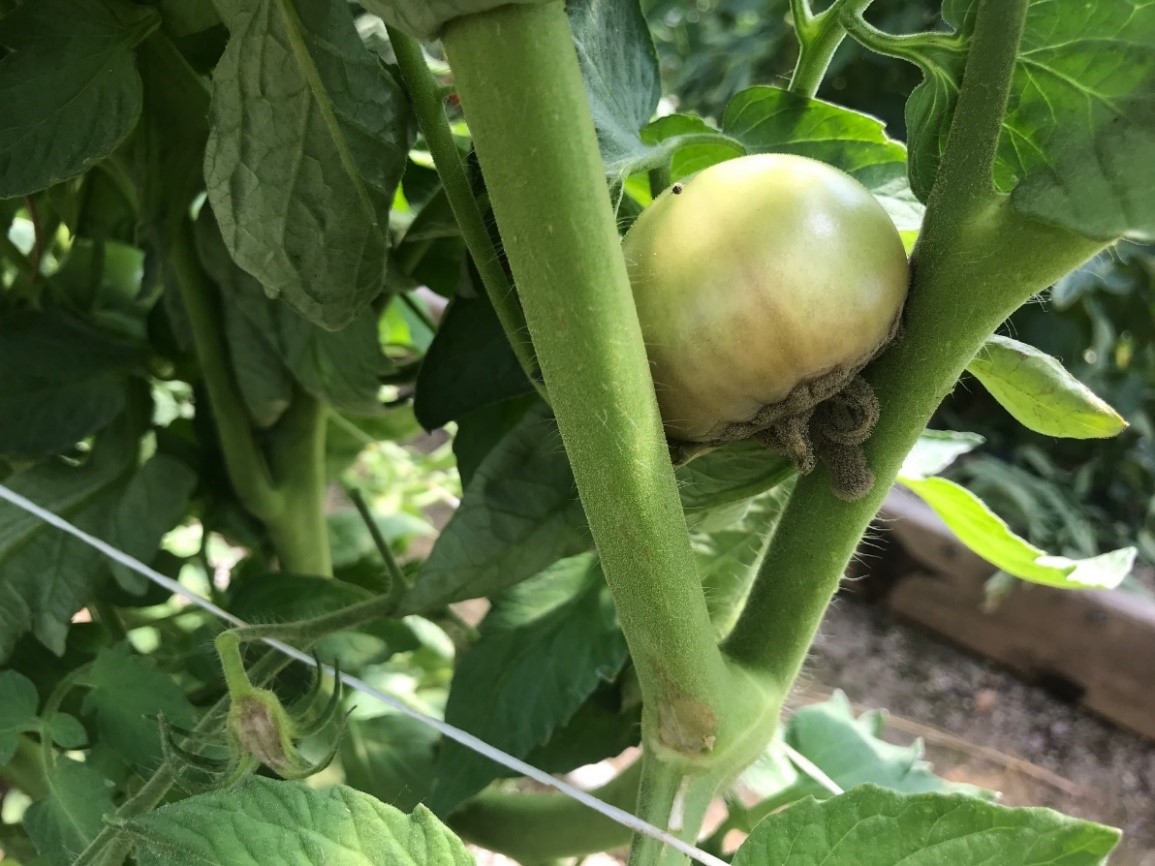
Gray mold on tomato stem and fruit from plant in high tunnels at DSAC. Photo by B. Aly.
We hosted a Southern Illinois Summer Twilight Series meeting on Monday, June 17th to provide the nearly 50 participants with information on our hydroponic and in-ground high tunnel research and demonstration plots. Dr. Wenjing Guan, Assistant Professor working out of the Southwest Purdue Agricultural Center, provided information to participants on grafting vegetables, explaining the different reasons why growers may want to consider utilizing grafted transplants to increase production in a high tunnel system. She also gave a brief overview of her NC-SARE project, “Improving Seedless Cucumber Production to Diversify High Tunnel Crops in the North Central Region” – project number LNC17-390, in which DSAC is one of the three locations conducting the research involved in this project. Lauren Smith, NRCS Soil Conservationist, discussed the EQIP cost share program for growers seeking help in the purchase of a high tunnel for their farm. She explained some of the steps and requirements needed for a successful application. Sharing information at an on-farm location allows growers to have a much more interactive experience, network with other growers, and ask about on-going, in season production concerns that may be observed at the location (like being able to look at our tomato diseases and actually see the mold and sclerotia on and in the tissue).
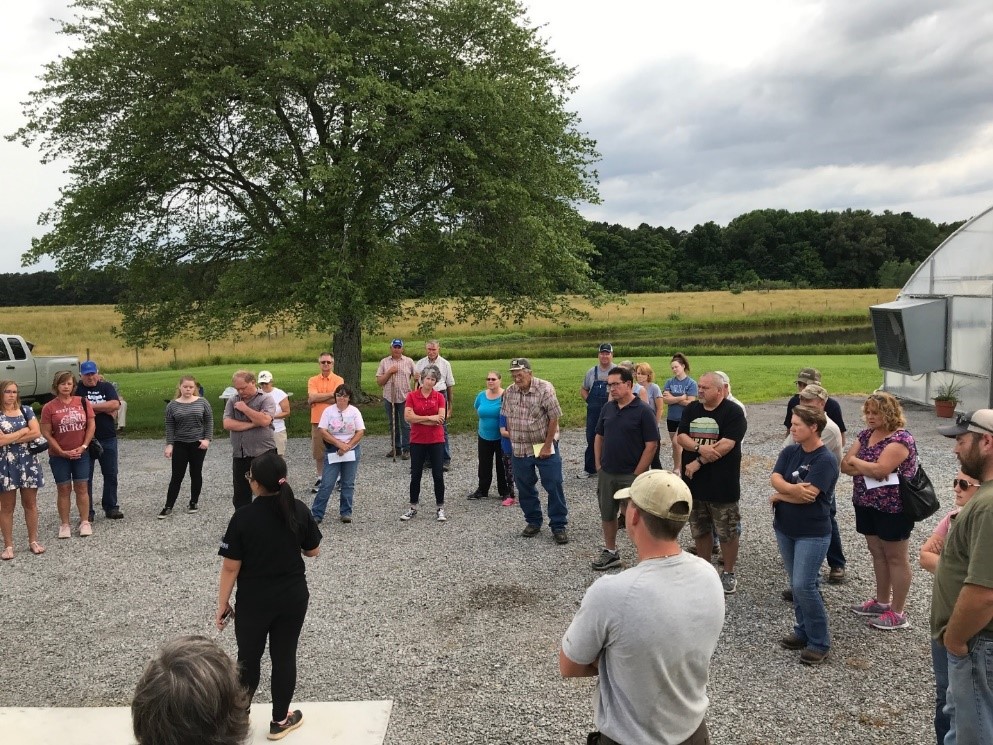
Dr. Wenjing Guan talking to participants about the potential benefits of grafted vegetable plants in a high tunnel production system during the June 17, 2019 Southern Illinois Summer Twilight Series meeting held at DSAC. Photo by B. Aly.
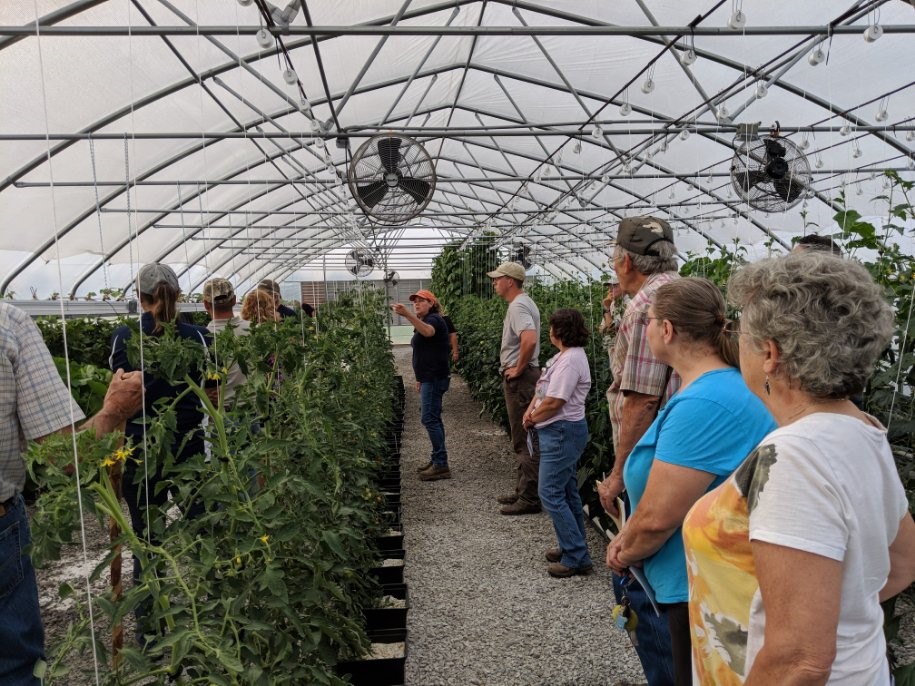
Gray mold on tomato stem and fruit from plant in high tunnels at DSAC. Photo by B. Aly.
In the hydroponic tunnel, we are experimenting with some strawberries being grown in a gutter system suspended above the row of herbs and edible flowers planted into an elevated rail system. Unlike the indeterminate tomatoes and cucumbers that are being trellised and trained vertically up individual strings, the herbs and edible flowers are only occupying about 2.5-3 feet of vertical space. The controlled environment that protected culture systems create becomes very valuable real estate for season extension, and with limited square footage, being able to utilize unused vertical space for more cropping opportunities can mean and increase in profit.
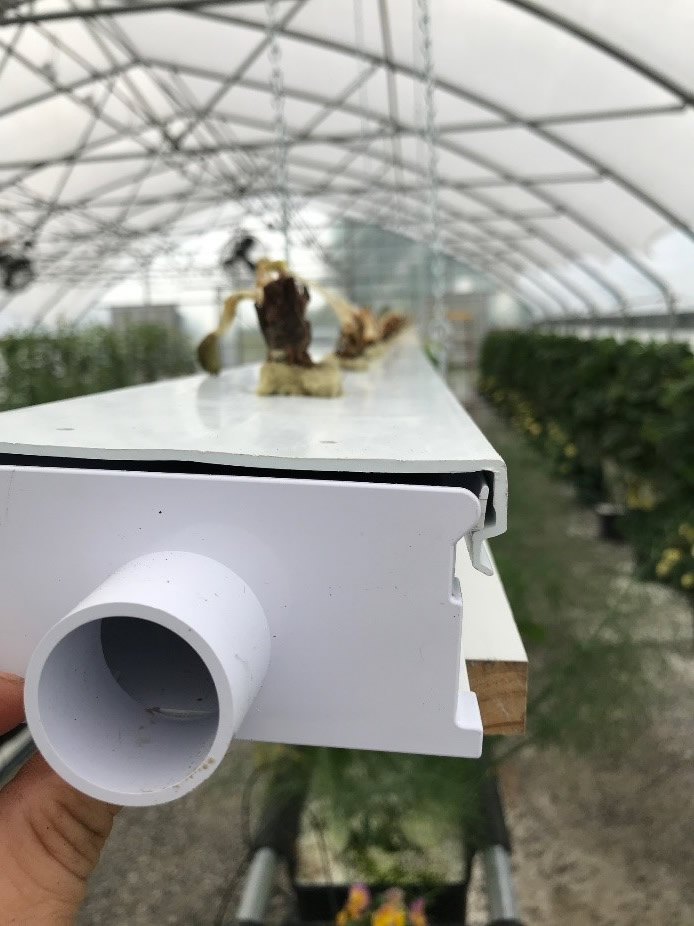
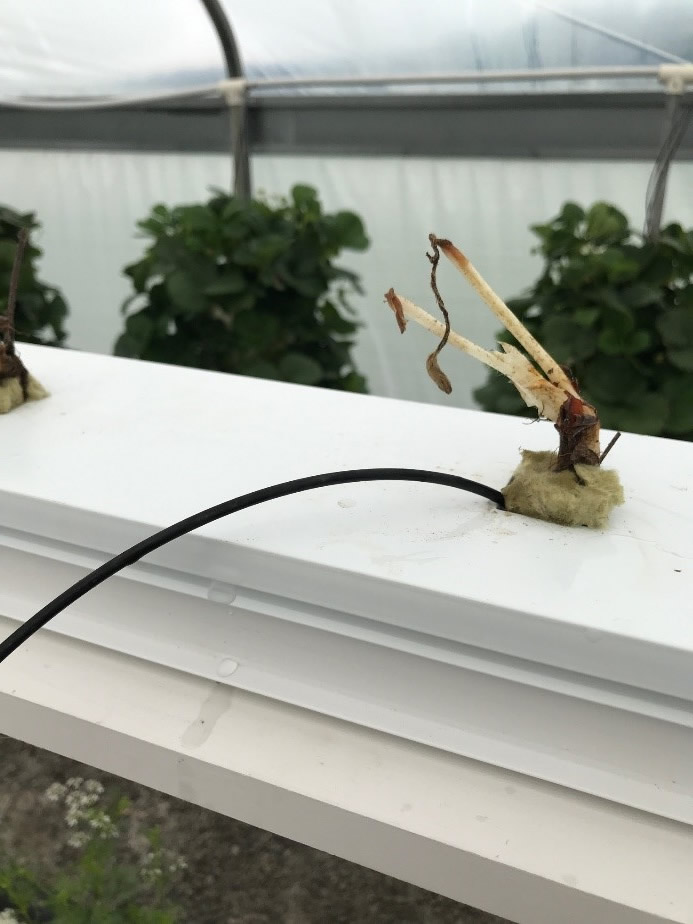
Strawberry plants suspended in a NFT gutter system above a rail system of herbs and edible flowers at DSAC. Irrigation tubes are spaced down the row to provide water and fertilizer. Photos by B. Aly.
The gutters used for this demonstration project are deeper than the ones we use in our NFT lettuce table, as we are hoping to give the strawberry roots plenty of air as they grow and fill up the inside of the gutter. We used ‘Monterey’ bare root strawberry plants left over from our planting in the vertical stack system that have been hanging out dormant in the refrigerator, split grodan rock wool cubes, put the plants in between the two halves, and pushed them into the square holes of the gutter. The grodan cubes are essentially being used to hold the crown of the plant in place, suspended above the trough at the approximate depth they should be planted if placed outside in a field setting. We put plants in place approximately two weeks ago, and nearly all of the plants have greened up and several are already setting their first flowers. We have spaced several point emitter tubes down the rail to deliver water and fertilizer on the same schedule that the vertical stack strawberries receive. Our main concerns with the longevity of this project are will the roots fill the trough to the point that no water with be able to travel down the run or will the roots stay too wet and not get enough air, hence drown the plants. Time will tell.
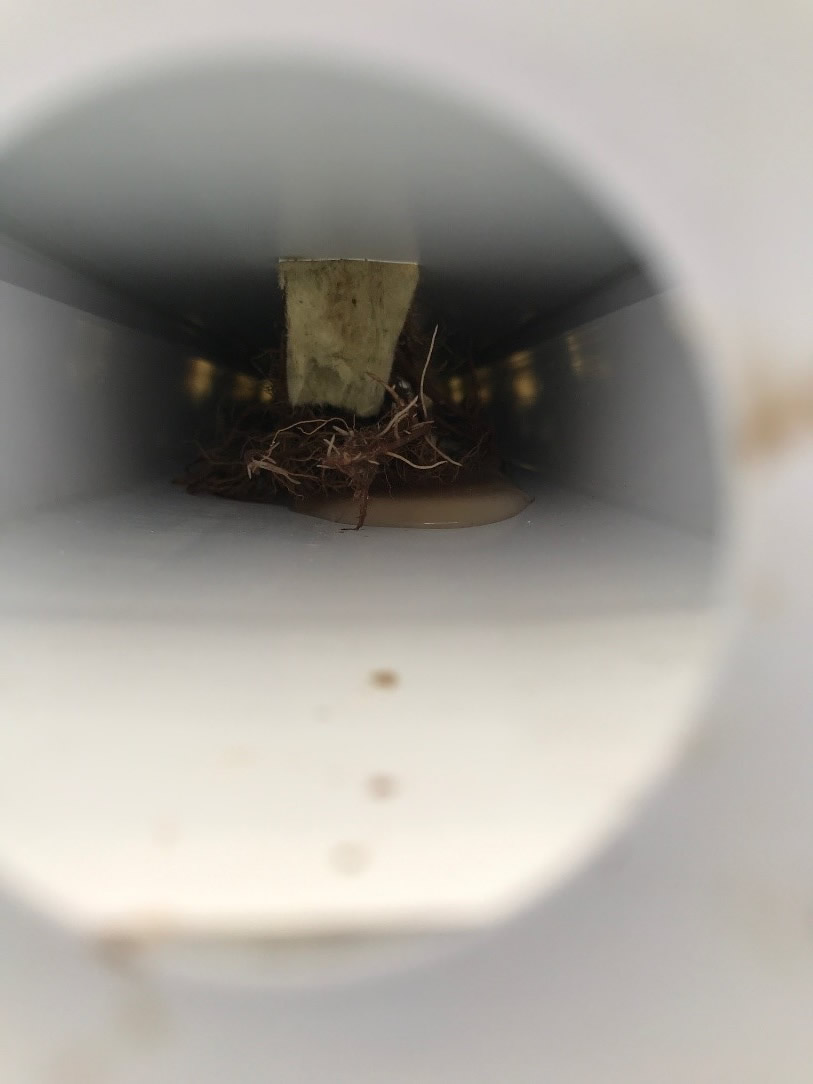
An inside view of the roots of the strawberry plants at the time of planting and water moving through the bottom of the trough. Photo by B. Aly.
Nathan Johanning (618-939-3434; njohann@illinois.edu)
Fruit and Vegetable Pest Management
Modified Growing Degree Days (Base 50⁰ F, January 1 through June17)
Station Location |
Actual Total |
Historical Average (11 year) |
One- Week Projection |
Two-Week Projection |
Freeport |
704 |
742 |
859 |
1014 |
St. Charles |
654 |
701 |
801 |
950 |
DeKalb |
693 |
801 |
851 |
1010 |
Stelle |
809 |
878 |
974 |
1141 |
Peoria |
922 |
921 |
1086 |
1255 |
Monmouth |
864 |
872 |
1022 |
1181 |
Champaign |
1031 |
954 |
1201 |
1374 |
Springfield |
1086 |
1042 |
1262 |
1442 |
Perry |
1069 |
979 |
1231 |
1396 |
Brownstown |
1141 |
1131 |
1319 |
1502 |
Olney |
1188 |
1107 |
1363 |
1543 |
Belleville |
1256 |
1164 |
1427 |
1608 |
Rend Lake |
1320 |
1261 |
1505 |
1695 |
Carbondale |
1334 |
1201 |
1506 |
1682 |
Dixon Springs |
1381 |
1281 |
1555 |
1735 |
Insect development is temperature dependent. We can use degree days to help predict insect emergence and activity. Degree day accumulations calculated using the Pest Degree-Day Calculator
Kelly Estes, State Survey Coordinator, Illinois Cooperative Agricultural Pest Survey (217-333-1005; kcook8@illinois.edu)
Farm inventory survey and farm inspections for Illinois under the Food Safety Modernization Act Produce Rule
By now, specialty fruit and vegetable growers in Illinois should be aware of the Food Safety Modernization Act (FSMA) Produce Rule, which was signed into law in 2011, became effective in 2016, and is the first mandatory federal standard for growing, harvesting, packing, and holding of fresh produce.
Early compliance efforts focused on working with businesses selling more than $250,000 in produce sales. State regulators are now focusing their efforts on small businesses, selling between $25,000 and $250,000 in produce sales, who must meet compliance standards by Jan. 26, 2020, explains Laurie George, a University of Illinois Extension local food systems and small farms educator. Farms selling less than $25,000 (adjusted for inflation) are exempt from the Produce Safety Alliance (PSA) Grower Training, but are still required to have documentation showing their exempt status.
In Illinois, the regulatory agency that oversees farm compliance is the Food and Drug Administration (FDA). Starting in spring 2019, the FDA initiated a farm inventory survey for all specialty growers to determine whether they fall under the FSMA Produce Rule. The FDA will be contacting growers via phone and email with a customized questionnaire. Answering the questions will help create an inspection priority to determine who falls under the regulation, and whether they will require an inspection this year. If the grower does not respond to the initial contact, the FDA may show up on the farm unannounced to gather the information, George says.
Because the compliance deadlines have passed for those farms that sell more than $500,000 in produce sales, there is a good chance that the FDA will be calling to set up a farm inspection starting this summer. For small farmers (farms with a three-year average of annual produce sales between $250,000 and $500,000), routine inspections should begin in spring 2020. Those farms selling between $25,000 and $250,000 in produce sales will see inspections starting around spring 2021. Routine inspections ensure that the specialty grower is compliant with the FSMA Produce Rule.
There are several different types of inspections that may occur:
- Routine inspections, as mentioned above.
- If there are any past food safety issues on the farm that have not been corrected.
- If a routine farm inspection found food safety issues that needed to be addressed, the FDA may show up unannounced to see that a correction has been made.
- If a farm fails to respond to an inspector’s call to schedule a routine inspection, the FDA may show up on the farm unannounced within five business days after the initial contact.
- If there is a complaint, recall, or foodborne outbreak investigation linked to a farm.
Information on FDA Produce Safety inspections is available to growers. The website talks about the inspections in general, links to the Produce Rule and related resources, and provides guidance documents and inspection-related documents, including form 4056 that the FDA will use during the farm inspection process.
If a farm operation is conducting processing or manufacturing activities that fall within the scope of the Preventative Controls Rule for Human Food, a separate inspection will most likely occur.
Key items to keep in mind:
- Designate someone from the farm to be the food safety representative when the FDA calls or arrives on the farm. This person should be familiar with the FSMA Produce Rule, and have taken a Produce Safety Alliance Grower Training class.
- The food safety representative (or a designee) should be diligent in checking the farm email and phone message system should the FDA call for an inspection date. Remember, the FDA will show up unannounced at the farm if their initial contacts are ignored.
- If you are interested in learning more about a farm inspection and what it entails, check out the FDA Produce Safety Inspections website.
If you have already taken a Produce Safety Alliance Grower Training, and want to make sure your farm is in compliance with the FSMA Produce Rules, the FDA is offering an On-Farm Readiness Review (OFRR). This review provides an opportunity for farmers to get individual feedback on their readiness for compliance before they receive their first inspection. This tool is consistent with the FDA’s, “Educate Before and While We Regulate” approach.
Farmers who have an interest in scheduling an OFRR of their farm should contact the FDA at RequestAnOFRR@fda.hhs.gov or by mail:
U.S. Food and Drug Administration
c/o Produce Safety Network
Center for Food Safety and Applied Nutrition
Fresh Produce Safety Branch (HFS 317)
5001 Campus Drive
College Park, MD 20740
For additional information concerning the FSMA Produce Rule, or the OFRR process in Illinois, please contact Laurie George at ljgeorge@illinois.edu or call (618) 242-0780.
Laurie George (618-548-1446; ljgeorge@illinois.edu) and Zachary Grant (708-449-4320; zgrant2@illinois.edu)
Less Seriously

An inside view of the roots of the strawberry plants at the time of planting and water moving through the bottom of the trough. Photo by B. Aly.

An inside view of the roots of the strawberry plants at the time of planting and water moving through the bottom of the trough. Photo by B. Aly.
https://www.juicyquotes.com/funny-fourth-of-july-joke/
University of Illinois Extension Specialists in Fruit and Vegetable Production & Pest Management
Extension Educators – Local Food Systems and Small Farms |
||
Bronwyn Aly, Gallatin, Hamilton, Hardin, Pope, Saline, and White counties |
618-382-2662 |
|
Katie Bell, Franklin, Jackson, Perry, Randolph, & Williamson counties |
618-687-1727 |
|
Sarah Farley, Lake & McHenry counties |
847-223-8627 |
|
Nick Frillman, Woodford, Livingston, & McLean counties |
309-663-8306 |
|
Laurie George, Bond, Clinton, Jefferson, Marion, & Washington counties |
618-548-1446 |
|
Zachary Grant, Cook County | 708-679-6889 | |
Doug Gucker, DeWitt, Macon, and Piatt counties |
217-877-6042 |
|
Erin Harper, Champaign, Ford, Iroquois, and Vermillion counties |
217-333-7672 |
|
Grace Margherio, Jackie Joyner-Kersee Center, St. Clair County |
217-244-3547 |
|
Grant McCarty, Jo Daviess, Stephenson, and Winnebago counties |
815-235-4125 |
|
Katie Parker, Adams, Brown, Hancock, Pike and Schuyler counties |
217-223-8380 |
|
Kathryn Pereira, Cook County |
773-233-2900 |
|
James Theuri, Grundy, Kankakee, and Will counties |
815-933-8337 |
|
Extension Educators – Horticulture |
||
Chris Enroth, Henderson, Knox, McDonough, and Warren counties |
309-837-3939 |
|
Richard Hentschel, DuPage, Kane, and Kendall counties |
630-584-6166 |
|
Andrew Holsinger, Christian, Jersey, Macoupin, & Montgomery counties |
217-532-3941 |
|
Extension Educators - Commercial Agriculture |
||
Elizabeth Wahle, Fruit & Vegetable Production |
618-344-4230 |
|
Nathan Johanning, Madison, Monroe & St. Clair counties |
618-939-3434 |
|
Campus-based Extension Specialists |
||
Kacie Athey, Entomology |
217-244-9916 |
|
Mohammad Babadoost, Plant Pathology |
217-333-1523 |
|